

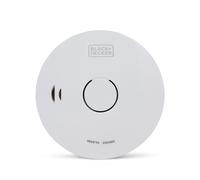
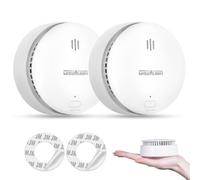
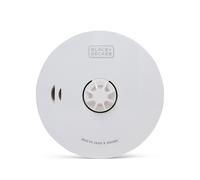
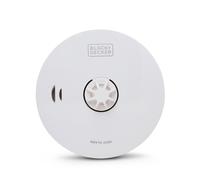
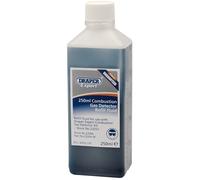
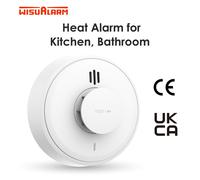



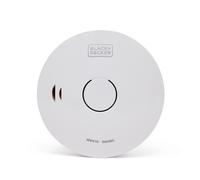


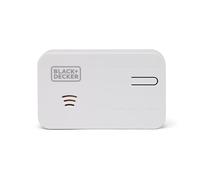


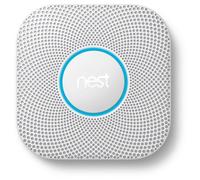
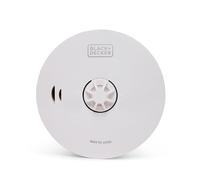



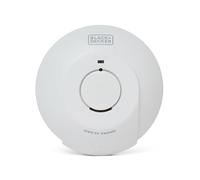
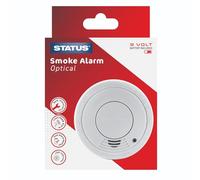
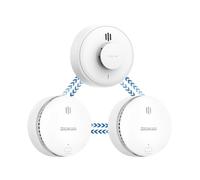

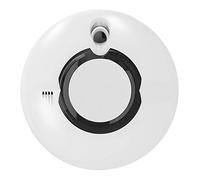

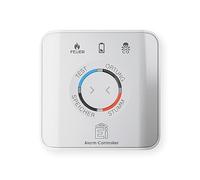

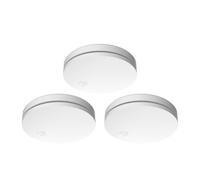
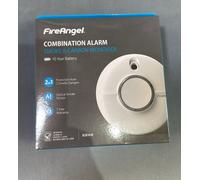


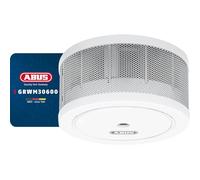



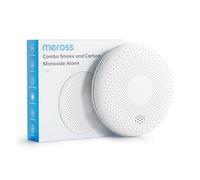

- 1
- 2
- 3
- 4
- 5
- next page
Exclusive Offers on Smoke Alarms You Can't Miss
Every year, around 300 people die in the UK as a result of fires. Most of them in their own homes and at night. However, the cause of death is seldom burns but smoke poisoning.
Since the sense of smell is not active during sleep, sleeping persons usually do not detect smoke or detect it too late. The solution is a smoke detector that sounds an alarm when smoke develops, which can be vital, especially in bedrooms.
The inhalation of smoke gases can cause serious damage to health. They essentially consist of three major groups:
- Irritant gases (hydrogen chloride and sulfur dioxide): they have a corrosive effect on mucous membranes and respiratory tract.
- Toxic gases (carbon monoxide and carbon dioxide): They prevent oxygen transport and cause suffocation.
- Soot particles: They cause burns to the lungs and mucous membranes.
Smoke detectors therefore function in a similar way to an early warning system, because the protection of the smoke detector kicks in immediately when a fire breaks out in your living space. Even a small amount of smoke, such as from a tipped-over candle, is enough to trigger the alarm signal. The alarm of the smoke detector therefore informs all persons about the fire who can hear the acoustic signal in the vicinity.
The functional principle of a classic smoke detector is relatively simple. In order for the smoke detector to sound the alarm at all, it must be able to detect the smoke in the event of a fire. This is done by the so-called smoke chamber, which is the heart of every smoke detector. Due to the cascades attached to the side, room air can penetrate, but insects or particles have no chance of penetrating the smoke detector and thus cannot trigger a false alarm.
In order to be able to emit an alarm sound, the smoke alarm device requires a transmitter and a receiver. The transmitter is a diode (infrared diode) that sends light to the receiver (photodiode). The infrared diode sends light signals at regular intervals. However, as long as there is no actual fire, the photodiode does not receive this signal due to its position. This is because the light signals require a reflector - in the case of a fire, these are the smoke particles - in order to be able to transmit the light signal to the receiver. Only when there is a reflection of the light, the receiver can pass it on to a processor, which evaluates the signal and triggers the alarm.
The installation of a smoke alarm is easy, as screws and other mounting materials are usually included. If you also have a wrench and, if necessary, a drill in the house, the installation of a smoke alarm should not be a problem for you. In addition to screws and plugs, most smoke detectors also come with operating and installation instructions that enable even non-professionals to install the devices without any problems.
When installing the smoke detector, it is not only the technical installation that is important, but also the selection of a suitable location. Basically, it is important that you install the detector on the ceiling as centrally as possible. The distance to lamps, ceiling fans or other attachments on the ceiling should be at least 50 centimetres. If the room is sloping, you should install the smoke detector on a horizontal surface if possible. If the walls in a room are all pointed, you may have to mount a small plate to bring the smoke alarm into a horizontal position.
Tip: Some manufacturers offer the installation of smoke alarms by means of an adhesive pad or magnetic pad, so that you do not have to deal with dirt, tools and drilling work.
In the UK, since October 2015 the following regulations apply: In all residential accomodations a smoke alarm needs to be installed on every storey containing at least one room used as a living accomodation, no matter if the accomodation is a house or flat. Living accomodations include dining rooms, kitchens, bathrooms, halls, children's rooms etc. If there is more than one flat on a storey of a house, one smoke detector has to be installed either outside the flats (communal alarm) or inside one of the flats being on the same floor.
Additionally, in all rooms that are used as a living accomodation and contain a solid fuel burning combustion appliance (stove, chimney) a carbon monoxide alarm must be installed.
The person responsible for the installation of both smoke alarm and carbon monoxide alarm is the landlord.
You should always install smoke alarms on the ceiling and ideally in the middle of the room. You should ensure that the distance to the nearest wall and to furnishings is at least 50 centimetres.
You should also ensure that the spreading smoke can reach the smoke alarm by not installing the smoke alarm in an area where there is a risk of draughts. So don't mount the smoke alarm near air conditioning units or ventilation outlets to prevent smoke from entering the detector.
We don't advise you to install additional smoke alarms in the bathroom and kitchen, as the risk of false alarms is very high here. However, if you do not want to do without protection in these rooms, there are alternative models such as heat detectors or carbon monoxide alarms.
When building a house, the builder is responsible for installing smoke detectors. In the case of owner-occupied and rented accommodation, however, the owner or landlord must install the smoke detectors.
If you, as the tenant, do not comply with your obligations regarding the maintenance and servicing of smoke detectors, you may be liable for any damage caused by a non-functioning or non-existent smoke detector.
Additionally, failure to have a smoke alarm and carbon monoxide alarm installed, as inquired by law, can result in a civil penalty of up to £ 5,000.
Most smoke detectors have a small button that you press down with a pen, tweezers or a bent paper clip. You may need to press the button for several seconds.
Smart smoke detectors that work with radio (wireless smoke detectors) can also be deactivated or reset via an app on your smartphone.
If the above measures do not help, remove the smoke alarm from the ceiling and remove the battery. Put it back in again afterwards. The false alarm should now no longer start.
If the smoke alarm continues to sound, the battery is probably dead. Simply install a new battery.
If that doesn't help either, the smoke alarm is probably defective and you should replace it with a working device.
Smoke detectors are usually powered by a nine-volt (9V) block battery, which is usually included in the delivery. Otherwise you find the battery that suits your device in our category “Batteries”. However, battery life varies. In the following we show you different types of batteries and their lifetimes:
| Battery | Lifetime |
| Lithium battery |
|
| Alkaline batteries |
|
| Integrated battery |
|
If you have purchased a smoke detector, it is best to keep track of the date of first use to prevent possible battery failure.
In the UK, the law is not very clear about the maintenance of fire alarm systems: it's only required to “adequately maintain” them. However, there is a recommendation (not regulation) by the government to have the fire alarm system inspected by a competent person at least every 6 months.
If you are responsible for the correct maintenance and testing of the smoke detector yourself, it is best to refer to the product's operating instructions. With most smoke detectors, a simple press of the test button is sufficient for the alarm test. If an alarm sounds, your smoke detector is in working order. Otherwise, you must replace or repair the product.
The visual inspection also includes checking whether all smoke inlet openings are free and whether the device is damaged from the outside. Checking whether the installation location is correct is also part of the visual inspection. Dirt or damage can be indicated by some high-quality devices apart from the alarm and visual inspection with a fault indication.
In rented flats, on the other hand, the landlord or an appointed company is responsible for the maintenance of the smoke detectors, unless there are other agreements in the rental contract.
Next to a smoke and/or heat detector a carbon monoxide alarm is obligatory if you have an oven or a chimney. And, of course, in case of fire, it is recommended to have a fire distinguisher at hand.
Exclusive Offers on Smoke Alarms You Can't Miss
When it comes to ensuring safety in your home, smoke alarms are indispensable. At pricehunter.co.uk, you'll find a wide variety of smoke alarms, ranging from basic models to advanced smart technology options, all listed from multiple retailers sorted by price. This guide will help you navigate the essential aspects of smoke alarms, ensuring that you make an informed decision tailored to your needs.Types of Smoke Alarms
Smoke alarms come in various types, each designed for specific environments and requirements. Understanding the differences is crucial to choosing the right one for your home.- Where to find smoke alarms - Various types available include ionization and photoelectric alarms.
- Ionization Alarms - Best for detecting fast-flaming fires.
- Photoelectric Alarms - Better at sensing smoldering fires.
- Combination Alarms - Offer both ionization and photoelectric features.
- Hardwired vs. Battery-Powered - Choose based on installation preferences.
Popular Brands of Smoke Alarms
Choosing the right brand can significantly influence the reliability and performance of smoke alarms. Several well-established brands are known for their innovation and safety features.- Best smoke alarms - Leading brands including Kidde and FireAngel.
- Kidde - Offers a range of models with integrated carbon monoxide detection.
- FireAngel - Known for advanced technology and user-friendly designs.
- First Alert - Offers reliable alarms with smoke and carbon monoxide detection.
- Honeywell - Features smart technology options for enhanced monitoring.
Smart Technology in Smoke Alarms
As technology advances, smoke alarms are becoming more sophisticated. Smart smoke alarms can provide enhanced safety features and convenience.- Kidde 7CO - A smart model with smartphone notifications.
- App Integration - Allows remote monitoring and alerts on your smartphone.
- Voice Alerts - Provides clearer warnings and information.
- Self-Testing Features - Automatically tests functionality to ensure reliability.
- Interconnectivity - Alarms can communicate with each other for comprehensive safety.
Installation and Maintenance
Proper installation and regular maintenance of smoke alarms are key to ensuring their effectiveness. Knowing what to do can save lives.- Smoke alarms prices - Consider installation costs along with the unit price.
- Installation Location - Should be installed on every level of the home, especially inside bedrooms and hallways.
- Regular Testing - Check alarms monthly to ensure functionality.
- Battery Replacement - Change batteries at least once a year or as needed.
- Replacement Schedule - Replace smoke alarms every 10 years to maintain effectiveness.
Safety Regulations and Audience
Understanding safety regulations is essential when selecting smoke alarms for various spaces. Different homes and audiences may have unique requirements.- CO alarm - Essential for homes with gas appliances.
- Regulations - Compliance with local fire safety codes is crucial.
- Homeowners with Young Children - Additional alarms may be needed for family safety.
- Multi-Story Homes - Require comprehensive coverage for increased safety.
- Rental Properties - Must meet specific safety regulations for tenant protection.